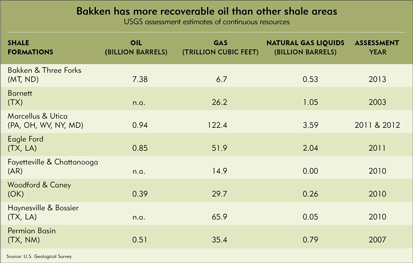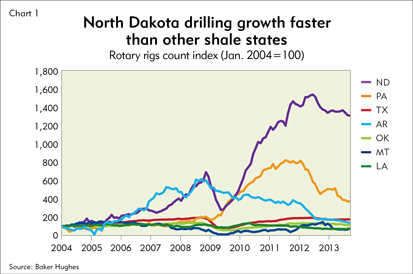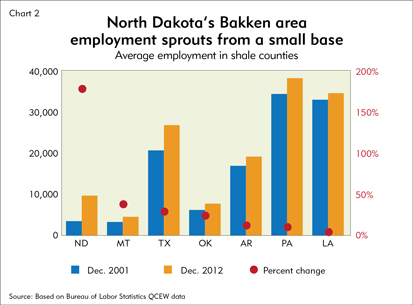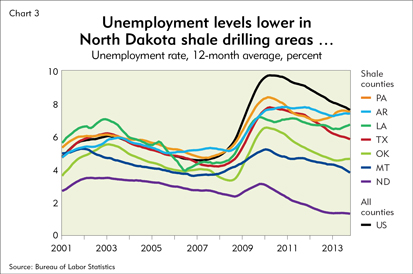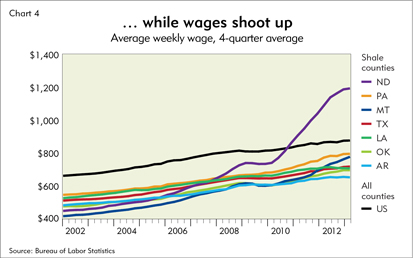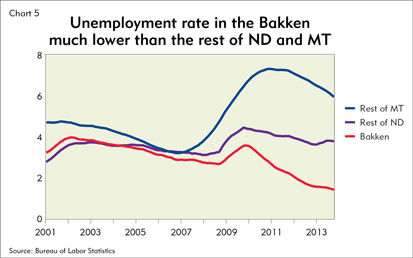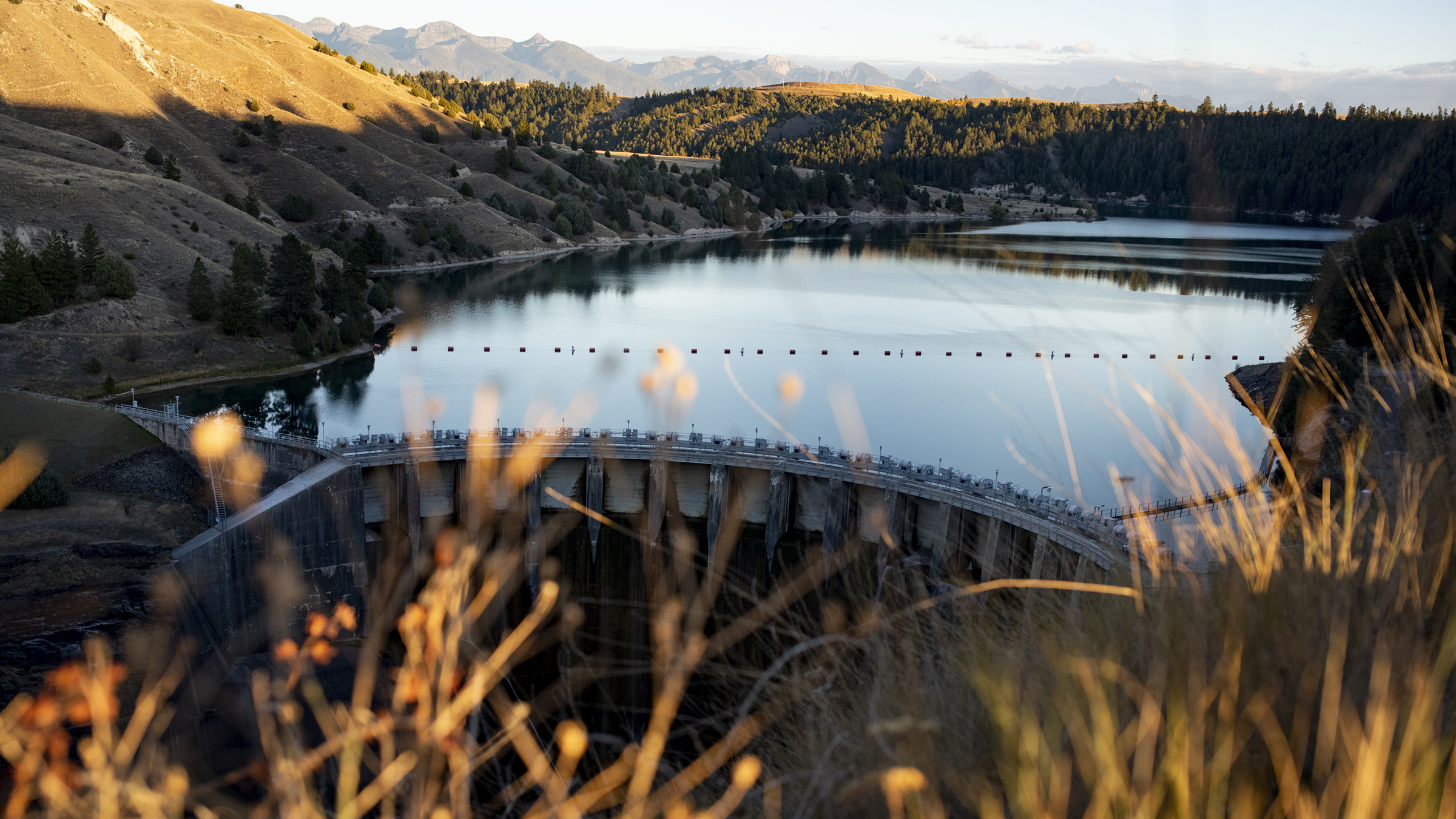The steady growth of U.S. oil and gas production in recent years has come from a number of shale formations across the country. But not every region is seeing the same growth in economic activity from the energy boom cracked open by horizontal drilling and hydraulic fracturing technology.
The Bakken and emerging Three Forks formations in North Dakota and eastern Montana stand out from other shale areas for a host of reasons. For starters, the formations have a large amount of relatively more profitable oil reserves, as opposed to gas reserves. The Bakken region also had a moderately small preboom population and workforce and little oil and gas infrastructure. As oil drilling and production increased, it generated a high fraction of well-paid employment in oil- and gas-related activities compared with other shale areas, thus helping to drive unemployment rates down and average wages up.
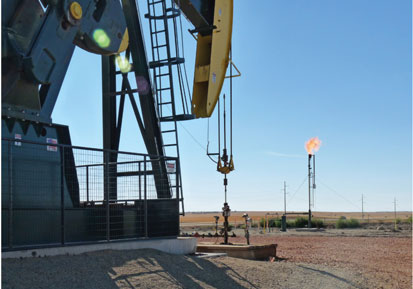
Start with what’s underground. In terms of total energy oil and gas content, the Bakken ranks about in the middle (see oil and gas shale area profiles for details). But the mix of that energy content is crucial. The Bakken has more recoverable oil than other shale formations (see table) and less natural gas and natural gas liquids, based on U.S. Geological Survey (USGS) estimates. That matters because oil prices have remained historically high since 2009, while natural gas prices have dipped, making oil relatively more profitable than natural gas and leading to greater increases in drilling and production compared with other regions.
Chart 1 illustrates the strong growth in active drilling rigs in North Dakota relative to other states with shale formations. Pennsylvania showed the next strongest growth in rigs, which started in 2009 with drilling in the Marcellus formation, but softened in 2012 as the price of natural gas remained low.
The increase in drilling activity in the Bakken has led to robust growth in oil and natural gas production. North Dakota’s oil production increased about 10-fold since 2001, and the state is now the second largest oil producer in the United States after Texas. In terms of gas production, Texas remains the leader, though both Pennsylvania and Arkansas posted solid growth in natural gas production.
Of course, one reason for the Bakken’s high growth in oil production is the relative scarcity of preboom activity. In 2004, North Dakota had an average of 15 active oil-drilling rigs operating in the state. By 2012, the state had over 180 active rigs.
In contrast, Texas already had a mature oil and gas industry prior to the horizontal drilling and hydraulic fracturing boom. In 2004, the state had 500 rigs in operation, which increased to 900 rigs by 2012. Much of the infrastructure necessary for this growth utilized infrastructure already in place for conventional oil and gas activities nearby and in the Barnett, Eagle Ford and Permian Basin formations.
Also, unlike states such as Texas and Oklahoma with established oil and gas activity, North Dakota and Montana started from a small oil and gas infrastructure base. In concert with the increase in drilling rigs, North Dakota and Montana had to build new pipelines, rail facilities, roads and municipal infrastructure in sparsely populated areas. The Bakken boom led to strong gains not only in oil field jobs, but also in construction, trucking and service jobs.
North Dakota also had the greatest percentage change in total employment across all sectors relative to shale counties in other states (see Chart 2, and see sidebar for how shale counties are selected). Average employment in North Dakota shale counties almost tripled from about 3,000 in 2001 to 8,500 in 2012. Job growth in other shale areas was below 40 percent. Despite this strong growth, the average employment in shale counties in North Dakota remains smaller than the average employment in shale counties in most other shale areas.
A much larger share of Bakken employment has been in natural resources and mining than in other shale areas. In 2012, just over a quarter of all workers in North Dakota’s shale counties were employed in this sector, most of them in oil and gas, which pays about three times the national average weekly wage. In comparison, the mining and natural resources employment share in other shale areas was about 5 percent.
As demand for labor picked up in the Bakken, the August 2013 unemployment rate dropped to 1.2 percent and 3.8 percent, respectively, in the North Dakota and Montana portions of the Bakken. While unemployment rates fell in other shale areas, none dropped as low as in the Bakken (see Chart 3). In a few areas, such as Pennsylvania, Arkansas and Louisiana, unemployment rates didn’t drop as much as the national unemployment rate dropped since 2009.
As labor markets tightened in the Bakken and relatively high-paying oilfield jobs grabbed a larger share of workers, average weekly earnings rose steeply compared with the national average and the average in other shale areas. In fourth quarter 2012, average weekly wages across all sectors reached $1,300 in the shale areas of North Dakota, higher than the national average of $950 and much higher than in other shale areas.
In fact, other than in Montana and somewhat in Pennsylvania, average weekly wages in other shale areas didn’t manage to close much of the wage gap with the national average (see Chart 4). This is because oil shale regions tend to be more rural (where wages are lower), and the share of jobs in the high-paying oil and gas sector remained low.
Comparing Bakken with Eagle Ford
While the Bakken has received much attention from news media and other observers of the oil and gas sector, the Eagle Ford formation in Texas has also caught plenty of interest. Unlike many other shale areas that have relatively high concentrations of natural gas, the Bakken and Eagle Ford formations both have relatively large oil prospects. How do these two areas compare in terms of oil production and economic activity?
While the USGS estimates a relatively modest reserve of oil in the Eagle Ford formation, the Energy Information Administration expects as much as 6 billion barrels of oil production from the Eagle Ford from 2012 through 2040 compared with over 8 billion barrels from the Bakken. According to the Railroad Commission of Texas, in the first half of 2013, Eagle Ford’s oil production averaged about 600,000 barrels per day. In comparison, the Bakken’s oil production as of June 2013 exceeded 800,000 barrels per day.
Despite similar oil production levels and promising prospects, from January 2008 to March 2013, the Bakken (including North Dakota and Montana counties) has seen more job growth than the Eagle Ford (47,000 versus 21,000) and a stronger rate of job growth (112 percent compared with 9 percent). The Bakken also enjoyed a lower unemployment rate (1.6 percent versus 6.5 percent as of August 2013) and a higher share of jobs in the natural resources and mining industry than the Eagle Ford (27 percent versus 7 percent). This advantage helped boost average wages in the Bakken. Average weekly wages since first quarter 2008 increased by $590 (88 percent) in the Bakken compared with $115 (20 percent) in the Eagle Ford.
Finally, and probably not surprisingly, there are distinct contrasts between the Bakken and the rest of North Dakota and Montana in employment growth, unemployment rates and average weekly wages. For example, the unemployment rate in the Bakken has dropped lower than the rate in the rest of North Dakota and much lower than the rate in the rest of Montana (see Chart 5).
Similar comparisons are available in the accompanying appendix for shale areas in other states. In most instances, the unemployment rate and average weekly wages in these shale counties move in a pattern similar to the rest of the counties in their states. While employment growth in the shale areas tends to be stronger than in the rest of their states, the difference in growth between the shale areas and the rest of their states is smaller than in the Bakken. Not only does the Bakken have better economic performance than other shale areas, its economic performance stands out in sharper contrast with the rest of its states’ counties than other shale areas.
(For production and geologic profiles of shale areas in this comparison, see appendix article.)
Data collection and analysis methods
References to the Bakken area include the Three Forks formation, which in large part is just underneath the Bakken formation. The Minneapolis Fed defines the Bakken area as nine counties in western North Dakota and three counties in Montana using quantitative and qualitative criteria.
This fedgazette analysis uses the general approach of Erik Gilje (Boston College) in his 2012 working paper “Does Local Access to Finance Matter? Evidence from U.S. Oil and Natural Gas Shale Booms” to identify shale counties. A county is considered a “shale county” when the area had at least 100 horizontal wells in 2011. Almost all the Bakken counties have over 100 horizontal wells; therefore, 100 is used as a benchmark for selecting counties in other shale areas. Virtually all the counties are within the boundaries of current “shale plays” as mapped by the Energy Information Administration. Using this definition, shale counties as a percentage of total counties in each state range from about 5 percent to 17 percent.
| Number of shale oil counties in each state | |
|---|---|
| Arkansas | 5 out of 75 |
| Louisiana | 6 out of 64 |
| Montana | 3 out of 56 |
| North Dakota | 9 out of 53 |
| Oklahoma | 9 out of 77 |
| Pennsylvania | 6 out of 67 |
| Texas | 31 out of 254 |
| Total | 69 out of 701 |
In making the Bakken versus Eagle Ford comparison, the Railroad Commission of Texas’ demarcation of Eagle Ford—24 counties in the southern part of the state—is used to define the Eagle Ford area, not horizontal well data.




